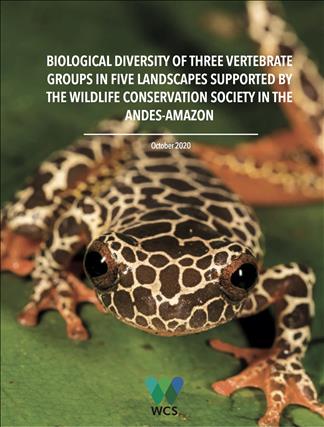Title
Biological Diversity of Three Vertebrate Groups in Five Landscapes Supported by the Wildlife Conservation Society in the Andes-Amazon
Author(s)
Robert Wallace; Omar Torrico; Vladimir Paye
Published
2020
Abstract
Biodiversity is a biological concept that describes the variability of all living things and can be measured and observed by the number of biological elements that coexist in certain dimensions of time and space (Cayuela & Granzow-de la Cerda, 2012). These variations are recognized in genes, individuals, species, communities and ecosystems. Species diversity includes speciation processes, population interaction, and extinctions, while ecosystem diversity includes ecological processes and interaction among different species (Ibisch, 2003). Genetic diversity provides organisms with small distinctions that determine differential survival and reproduction, which allow the evolution of species through natural selection processes (Jiménez-Sierra, 2016).
Biological diversity is not homogeneously distributed on the planet, and the largest nations are not necessarily the most diverse. On a global scale, there are more species per unit area in the tropical regions than in those with temperate or cold climates (Jiménez-Sierra, 2016). Tropical forests cover only 10% of the earth’s surface. However, their importance on a global scale is signifi cant because in addition to hosting more than 70% of the total species of mammals, birds, reptiles, amphibians, plants and insects on the planet (Malhi, 2000; Groombridge, 2003; UNEP, 2010), they capture and process large amounts of carbon released into the atmosphere by human activity due to the consumption of fossil fuels (Wright, 2010). Through satellite images, it has been estimated that tropical forests cover about 11 million km2 (Achard, 2007). The largest area is in the Americas (55%), followed by Asia (33.8%) and Africa (11.2%). Thus, the tropical region of the American continent, also known as the Neotropics, is of great interest for the study of biodiversity and its conservation (Cayuela & Granzow-de la Cerda, 2012).
South America holds almost half of the world’s tropical forests and is the most biologically diverse region in the world (UNEP, 2010). Of the 14 countries that make up this region, eight of them include portions of the Amazon region: Brazil, Peru, Ecuador, Colombia, Bolivia, Guyana, Suriname, French Guiana and Venezuela. According to the classification of South American bird species (BirdLife, 2018), the total number of species is 3,607, of which 2,502 are found in the Amazon. As for amphibians, the AmphibiaWeb portal records a total of 2,921 species for South America and 1,350 species for the Amazon. Finally, in the case of mammals, the International Union for Conservation of Nature (IUCN, 2019) reports that South America has 1,385 species, of which 874 are found in the Amazon.
Currently, biodiversity faces threats that are also not evenly distributed over the surface of the planet. Large-scale destruction, degradation, and pollution of natural habitats, along with the introduction of exotic species and the effects of climate change, threaten biodiversity today. For these reasons, and considering that the Andes-Amazon is one of the regions with the greatest biodiversity and endemism, it is important to identify priority areas for conservation (Buytaert et al., 2011; Young et al., 2015).
The Wildlife Conservation Society (WCS) implements a successful landscape conservation program across the world, based on wilderness sites relevant for their outstanding biodiversity and wildlife values. The WCS mission is to save wildlife and natural landscapes around the world through science, conservation action, education, and inspiring people to value nature. To this end, WCS focuses its efforts on 15 regions of the world that include landscapes and seascapes, which are characterized by encompassing intact natural areas, representing the planet’s biodiversity and being resilient to climate change or providing opportunities for species to adapt to environmental changes. One of these regions is formed by the Andes and the Amazon, harboring the largest tropical forest and the largest freshwater network in the world, providing a wide variety of extraordinary environmental services. WCS has prioritized five landscapes in the Andes-Amazon that integrate protected areas, indigenous territories and natural spaces.
Determining the biological diversity in each landscape and the groups of landscapes as a whole, and listing the threatened species and the endemic species they contain, will help to demonstrate the importance of actions for their conservation. From a biodiversity perspective, this spatially explicit information can also be used to identify priority areas for conservation. Finally, the results generated in the analysis herein will help disseminate to decision makers, funders and broader society, the conservation efforts that WCS carries out in these globally signifi cant landscapes.
ISBN: 978-99974-926-4-7
Full Citation
Wallace, R., O. Torrico, and V. Paye (2020). Biological Diversity of Three Vertebrate Groups in Five Landscapes Supported by the Wildlife Conservation Society in the Andes-Amazon. La Paz, Bolivia: Wildlife Conservation Society, Bolivia, 1-53.
Access Full Text

Back
DMX4201100000